Scientific name Sparassodonta Rank Order | Infraclass Metatheria | |
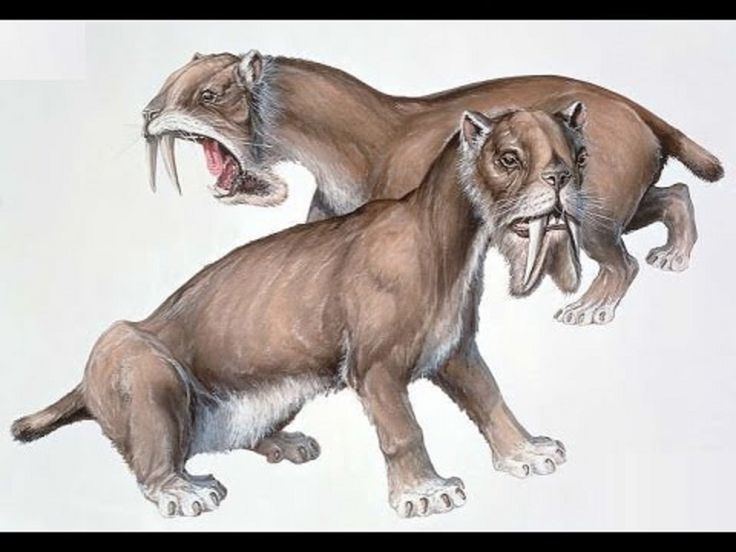 | ||
Lower classifications Thylacosmilus, Hathliacynidae | ||
Sparassodonta is an extinct order of carnivorous metatherian mammals native to South America. They were once considered to be true marsupials, but are now thought to be either a sister taxon to them, or considerably distantly related, part of a separate clade of Gondwanan metatherians. A number of these mammalian predators closely resemble placental predators that evolved separately on other continents, and are cited frequently as examples of convergent evolution. They were first described by Florentino Ameghino, from fossils found in the Santa Cruz beds of Patagonia. Sparassodonts were present throughout South America's long period of "splendid isolation" during the Cenozoic; during this time they shared the niches for large warm-blooded predators with the flightless terror birds. Previously, it was thought that these mammals died out in the face of competition from "more competitive" placental carnivorans during the Pliocene Great American Interchange, but more recent research has showed that sparassodonts died out long before eutherian carnivores arrived in South America (aside from procyonids).
Contents

Features

Although members of the order Sparassodonta showed many similarities with placental carnivores, they were not closely related and are a very good example of convergent evolution. For example, sparassodonts' molars were very similar to the sharp teeth of placental carnivores. The canines were also lengthened, and in some cases resemble those of saber-toothed cats. Sparassodonts spanned a wide range of body sizes, from 2.2 pound (1 kg) weasel or civet-like forms to Thylacosmilus, which was the size of a leopard. Along with the Australian thylacoleonids, sparassodonts include some of the largest metatherian carnivores.
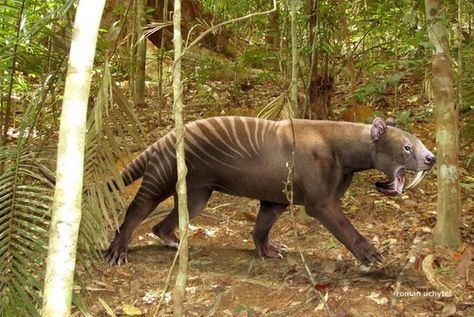
Sparassodonta is characterized by dental synapomorphies that distinguish the group from other closely related mammals. Unequivocal traits uniting the earliest Sparassodonts include:
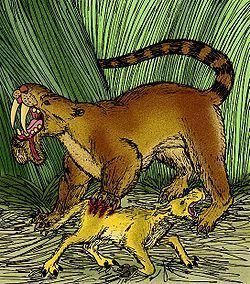
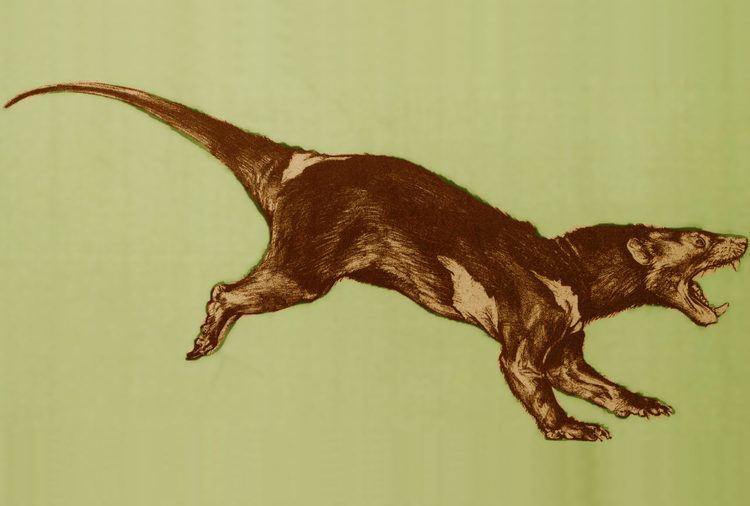
The dental formula of most sparassodonts is 4.1.3.43.1.3.4, with the exception of borhyaenids, which have lost an upper incisor, proborhyaenids (except for Callistoe), which have lost a lower incisor, and thylacosmilids, which have lost one premolar, two lower incisors, and at least two upper incisors. Some specimens of Borhyaena and Arctodictis are also missing the last upper molar, showing that the presence of this tooth was variable in these species. Sparassodonts had a typical metatherian mode of dental replacement, replacing only the upper and lower third premolar throughout their lifetime. In thylacosmilids, this tooth was never replaced.
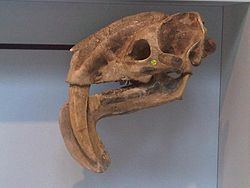
Sparassodonts have highly reduced epipubic bones, to the point that early analysis couldn't even find evidence for them. This is a characteristic shared with the Australian thylacine, and historically argued as a synapomorphy, though nowadays its considered to have developed independently for poorly understood reasons. Like with thylacines, it is very likely that they possessed long cartilaginous elements instead.
Evolutionary history
The early history of the Sparassodonta is poorly known, as most Paleocene and Eocene members of this group are only known from isolated teeth and fragmentary jaws. However, one species, the middle Eocene Callistoe vincei, is known from a nearly complete, articulated skeleton. As Callistoe belongs to one of the most specialized groups of sparassodonts, this indicates that the other major groups (e.g. borhyaenids, hathliacynids, etc.) must have also arisen by this time. Originally, the early Paleocene metatherian Mayulestes was considered to be the earliest known member of the Sparassodonta, but phylogenetic analyses suggest that this species represents an independent radiation of carnivorous metatherians more closely related to Pucadelphys; however, recent studies show that these taxa were closely related to borhyaenids. As of this writing, the earliest known true sparassodonts are either Allqokirus australis, a species from the same site as Mayulestes which may also turn out to not be a sparassodont, and an isolated astragalus from the earliest Paleocene site of Punta Peligro, Argentina. Marshall and colleagues in 1990 considered the Cretaceous stagodontids to also be a member of the Sparassodonta, but this was criticized by later authors. A more recent study found sparassodonts to line up with several non-marsupial metatherian taxa from the Paleocene of South America, as well as the asiatic "Gurlin Tsav skull" from Mongolia, while marsupials are instead more closely related to Cretaceous north american metatherians, including stagodontids. The australian Murgon taxa Archaeonothos has also been noted as being similar to sparassodonts, but currently its relationships are not fully concluded.
Sparassodonts can be divided into six major groups; basal sparassodonts (?earliest Paleocene-late Miocene), species that cannot be easily assigned to any of the other sparassodont groups and whose teeth often exhibit adaptations for omnivory; hathliacynids (late Oligocene-early Pliocene/late Pliocene), which range from a marten to a thylacine in size, and have long, fox-like snouts and teeth strongly adapted for carnivory; basal borhyaenoids (middle Eocene-late Miocene), borhyaenoids that cannot be easily classified into the families Borhyaenidae, Thylacosmilidae, or Proborhyaenidae and vary in size and shape; borhyaenids (early-late Miocene), the sparassodont group most specialized for running, but not as much as living carnivorans or even thylacines; proborhyaenids (middle Eocene-late Oligocene), robust, wolverine-like forms with ever-growing upper and lower canines; and thylacosmilids (early Miocene-late Pliocene), another terrestrially specialized group with ever-growing saber-like upper canines. With the exception of some basal sparassodonts, all members of this group were hypercarnivorous. Based on studies of the postcranial skeleton, it appears as though most sparassodonts were scansorial (adapted for climbing), although terrestrial adaptations evolved in Lycopsis longirostrus, borhyaenids, proborhyaenids, and thylacosmilids.
After the middle Miocene, sparassodonts began to slowly decline in diversity. Basal borhyaenoids are last known from the early late Miocene (Pseudolycopsis cabrerai and Lycopsis viverensis), and after this time were at least partially replaced by large-bodied basal sparassodonts such as Stylocynus. It has been suggested that this shift in dominance was due to the more omnivorous habits of basal sparassodonts, which may have been better able to exploit the more seasonal climates of South America during the late Neogene. Borhyaenids are last known from the latest Miocene, though only fragmentary remains of this group are known from this period. Later remains assigned to this group have since been reidentified as thylacosmilids or procyonids. By the Pliocene, only two families of sparassodonts remained in South America, the Hathliacynidae and the Thylacosmilidae. Pliocene hathliacynid remains are rare, and it is possible that these animals may have competed with the large carnivorous didelphids such as Lutreolina that appeared around this time. Hathliacynids are last definitively known from the early Pliocene, though it has been suggested that the genus Borhyaenidium may have survived into the late Pliocene. The thylacosmilids, on the other hand, were more successful and abundant, being some of the only large mammalian carnivores in South America during the Pliocene, and only died out at the end of the epoch. It is still not certain why the Sparassodonta declined in diversity and became extinct during the late Cenozoic, but it appears as though competition from eutherian carnivorans was not a factor, as the placental analogues of sparassodonts (dogs, weasels, and saber-toothed cats) did not enter South America until the middle Pleistocene, several million years after their sparassodont counterparts became extinct. The overall decline in sparassodont diversity from the late Miocene to the end of the Pliocene may be linked to the cooling climates following the middle Miocene climatic optimum and the onset of the Pleistocene ice ages.
Classification
The following cladogram of sparassodont interrelationships is after Suárez et al., 2015. Not all studies agree on the sister group relationship between Thylacosmilidae and Borhyaenidae recovered here, with other studies finding thylacosmilids to be more closely related to proborhyaenids. The relationships among hathliacynids are also relatively unstable.
Within Metatheria, a 2016 phylogenetic analysis group found that borhyaenids form a clade with the Asian "Gurlin Tsav skull" as well as other South American taxa. The same phylogeny found that marsupials group among various North American Cretaceous species. The phylogenetic tree is reproduced below.
Taxonomy
The taxonomic classification below follows the latest review of the group, that of Forasiepi, 2009, with additions from more recent studies. Although Mayulestes was originally described as a sparassodont, later phylogenetic analyses have shown that it most likely does not belong to this group; however more recent studies show it to be closely related to sparassodonts. Similarly, while basal borhyaenoids such as Lycopsis and Prothylacynus were once thought to belong to a distinct family (Prothylacynidae), phylogenetic analyses have found that these animals do not represent a monophyletic group. The exact age of most Eocene species of sparassodonts is uncertain, given the lack of precise stratigraphic information associated with most specimens and the recent division of the Casamayoran SALMA into the Vacan and Barrancan SALMAs.
